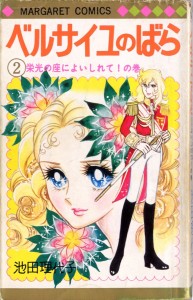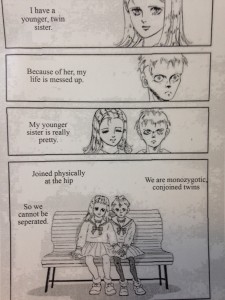This upcoming fall there will be a shojo manga art exhibition in Vassar’s Palmer Gallery and Dutchess Community College’s Washington Gallery from October 29th to November 21st. Vassar College’s Professor Dollase is collaborating with Professor Toku of California State University, Chico (Curator of the Exhibition), Teresa Quinn (Director of Palmer Gallery), Monica Church (Associate Director of Palmer Gallery) and Margaret E. Craig (Professor of Art History at Dutchess Community College) to make this exhibition possible. My job this summer was to assist Professor Dollase in the planning of this exhibition, contribute to the gallery with English translations of manga, and prepare a speech about shojo manga to give at Vassar and Dutchess Community College on two unknown dates.
Now why should you come to this shojo manga art exhibition? What is shojo manga? Manga are Japanese graphic novels, and they are split into two categories: shojo manga (marketed towards a female audience) and shonen manga (marketed towards boys). My focus this summer was on shojo manga, which is such an important part of Japanese culture that there are even classes on manga in Japanese universities! Women of all ages read shojo manga, and it is distinguishable by its use of large eyes and cute, feminine men. Shojo manga isn’t just love stories and fantasies; there is an underlying importance in shojo manga artists’ usage of love, gender fluidity, and homosexual relations that suggests something important about the emotions of girls in Japan. Japanese girls strive for true love and a better life, but shojo manga also suggests that there are still issues with equality in heterosexual relationships.
Rose of Versailles by Riyoko Ikeda: A popular and influential shojo manga.
The art exhibition is comprised of pictures of the artwork in shojo manga, not the books themselves. As part of my internship, I translated two works from Japanese to English with the help of Professor Dollase. One of the translations will be in Vassar’s Palmer Gallery during the exhibition. With this addition, visitors can read some shojo manga stories and see the book form, instead of just viewing singular pictures of covers and pages in the gallery. Having visitors see actual manga books will help introduce them to Japanese popular culture. The rest of my project was dedicated to researching Japanese culture, reading manga from the 1960s to the 1990s, and using this knowledge to make a speech and PowerPoint presentation to present at later dates in the fall. My speech topic will be the importance of love in Japanese shojo manga, so I will be discussing the history of love in Japan, the variety of love portrayed in manga, and what this variety suggests about love and relationships for girls in Japan.
A page of the translation that will be shown in Vassar’s Palmer Gallery.
If you have time in the fall, please stop by either Vassar College or Dutchess Community College between October 30th and November 21st to delve into the interesting world of shojo manga!


